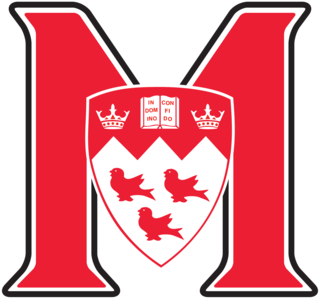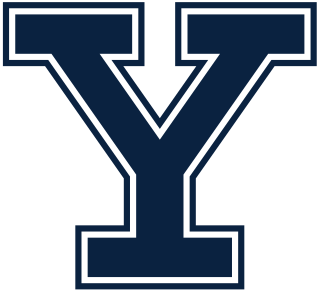
College football refers to gridiron football that is played by teams of amateur student-athletes at universities and colleges. It was through collegiate competition that gridiron football first gained popularity in the United States.

In several forms of football, a forward pass is the throwing of the ball in the direction in which the offensive team is trying to move, towards the defensive team's goal line. The legal and widespread use of the forward pass distinguishes gridiron football from rugby football from which the gridiron code evolved, in which the play is illegal.

Gaelic football, commonly known as simply Gaelic, GAA or Football is an Irish team sport. A form of football, it is played between two teams of 15 players on a rectangular grass pitch. The objective of the sport is to score by kicking or punching the ball into the other team's goal or between two upright posts above the goal and over a crossbar 2.5 metres above the ground.

Gridiron football, also known as North American football, or in North America as simply football, is a family of football team sports primarily played in the United States and Canada. American football, which uses 11 players, is the form played in the United States and the best known form of gridiron football worldwide, while Canadian football, which uses 12 players, predominates in Canada. Other derivative varieties include arena football, flag football and amateur games such as touch and street football. Football is played at professional, collegiate, high school, semi-professional, and amateur levels.
The Oneida Football Club, founded and captained by Gerrit Smith Miller in Boston, Massachusetts, in 1862, was the first organized team to play any kind of football in the United States. The game played by the club, known as the "Boston game", was an informal local variant that combined association and rugby football and predated the codification of rules for American football.
The history of American football can be traced to early versions of rugby football and association football. Both games have their origin in multiple varieties of football played in the United Kingdom in the mid-19th century, in which a football is kicked at a goal or kicked over a line, which in turn were based on the varieties of English public school football games descending from medieval ball games.

The Harvard Rugby Football Club is the National Collegiate Athletic Association (NCAA) Division I rugby union program that represents Harvard University in the Ivy Rugby Conference. Having been established in December 1872, Harvard has the oldest rugby college program in the United States.

The Harvard Crimson football program represents Harvard University in college football at the NCAA Division I Football Championship Subdivision. Harvard's football program is one of the oldest in the world, having begun competing in the sport in 1873. The Crimson has a legacy that includes 13 national championships and 20 College Football Hall of Fame inductees, including the first African-American college football player William H. Lewis, Huntington "Tack" Hardwick, Barry Wood, Percy Haughton, and Eddie Mahan. Harvard is the tenth winningest team in NCAA Division I football history.
The 1870 college football season is regarded as the second United States intercollegiate football season. The season involved only three teams and two known games which took place in November 1870. As in 1869, the season's two games occurred about fifteen miles apart in New Brunswick and in Princeton, New Jersey.

Football is a family of team sports that involve, to varying degrees, kicking a ball to score a goal. Unqualified, the word football normally means the form of football that is the most popular where the word is used. Sports commonly called football include association football ; Australian rules football; Gaelic football; gridiron football ; International rules football; rugby league football; and rugby union football. These various forms of football share, to varying degrees, common origins and are known as "football codes".
The Yale Bulldogs men's soccer program represents Yale University in all NCAA Division I men's college soccer competitions. Founded in 1908, the Bulldogs compete in the Ivy League.
The 1869 Princeton vs. Rutgers football game was played between Princeton and Rutgers on November 6, 1869. The rules governing play were based on the London Football Association's 1863 rules that disallowed carrying or throwing the ball. Therefore, the game more closely resembled soccer than gridiron football. Moreover, the match was played with a soccer ball. As a result, it is considered the first collegiate soccer match and the birth of soccer in the United States.

The McGill Redbirds football team represents McGill University in Canadian football in U Sports and is based in Montreal, Quebec. The program is one of the oldest in all of Canada, having begun organized competition in 1874. The team won its first collegiate championship in 1902 and also won in 1912, 1913, 1919, 1928, 1938 and 1960 prior to the inauguration of the Vanier Cup in 1965. McGill appeared in the Vanier Cup final in 1969, 1973 and 1987, with the Redmen finally winning the title in the 1987 game. McGill plays out of Percival Molson Memorial Stadium, where the Canadian Football League's Montreal Alouettes also play.

The Yale Bulldogs Rugby Team, or simply, Yale Rugby is the rugby union team of the Yale University. Yale has fielded a team that has played using the rugby rules since at least 1876. The school competes in the Ivy Rugby Conference and in Division I-AA of USA Rugby's intercollegiate competition. The YRFC plays a fall and spring schedule, which includes both a 15s and a 7s program. The team has approximately 45 players and is coached by Head Coach, Craig Wilson and Assistant Coaches Brad Dufek, Alycia Washington and Greg McWilliams.
The 1873–74 Harvard Crimson football team represented Harvard University in the 1873 college football season. The team played only two intercollegiate games, both against the team from McGill University in Cambridge, with one game ending in a Harvard victory and the other ending in a scoreless tie. The first game was played under Harvard's rules, while the second game played using McGill's rules on May 15, 1874, was the first rugby-style football game played in the United States. The team captain was Henry R. Grant.

The 1874 Harvard vs. McGill football game was a two-game series between the Harvard Crimson and the McGill Redmen held in Cambridge, Massachusetts, on May 14 and 15, 1874.

The early history of American football can be traced to early versions of rugby football and association football. Both games have their origin in varieties of football played in Britain in the mid–19th century, in which a football is kicked at a goal or run over a line, which in turn were based on the varieties of English public school football games.
The Intercollegiate Football Association (IFA), also known as the American Intercollegiate Football Association, was one of the earliest college football rules-making and scheduling organizations in existence; it was active from the 1873 to 1893 seasons. The IFA teams, Columbia, Harvard, Princeton, and Yale, are now members of the Ivy League.

The first recorded match between two colleges in game played in United States using rugby union code rules occurred on May 14, 1874 between Harvard University and McGill University. Predating rugby using the rugby union rules were rugby union style "carrying games" with use of hands permitted including a game between Harvard College Freshmen and Sophomores at a game played at Harvard campus in 1858. Harvard varsity interscholastic rugby team was not founded until December 6, 1872

The Oneida Football Club Monument, sometimes called Football Tablet, is a monument by Joseph Coletti and installed on the Boston Common, in Boston, Massachusetts, United States.













